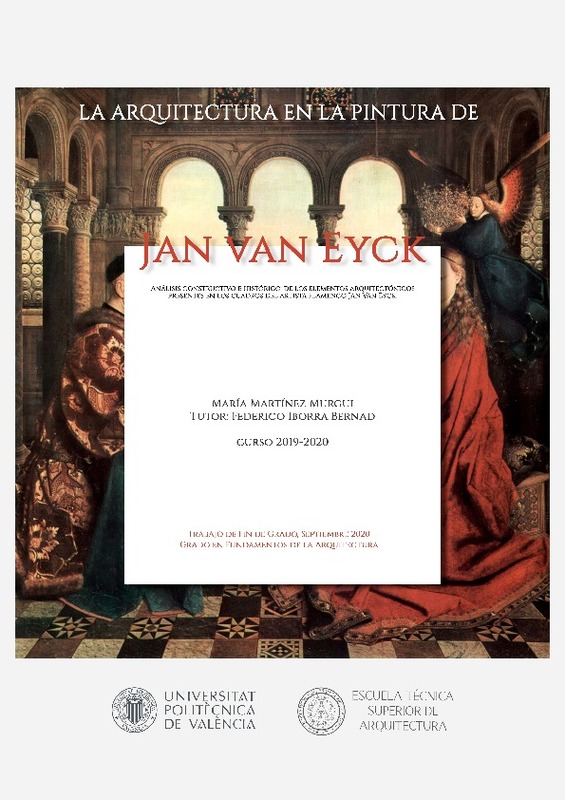JavaScript is disabled for your browser. Some features of this site may not work without it.
Buscar en RiuNet
Listar
Mi cuenta
Estadísticas
Ayuda RiuNet
Admin. UPV
La arquitectura en la pintura de Jan van EyckAnálisis constructivo e histórico, de los elementos arquitectónicos presentes en los cuadros del artista flamenco Jan Van Eyck.
Mostrar el registro sencillo del ítem
Ficheros en el ítem
| dc.contributor.advisor | Iborra Bernad, Federico Javier
|
es_ES |
| dc.contributor.author | Martínez Murgui, María
|
es_ES |
| dc.date.accessioned | 2021-09-01T10:29:25Z | |
| dc.date.available | 2021-09-01T10:29:25Z | |
| dc.date.created | 2020-09-18 | |
| dc.date.issued | 2021-09-01 | es_ES |
| dc.identifier.uri | http://hdl.handle.net/10251/171144 | |
| dc.description.abstract | [ES] Jan Van Eyck es considerado el pintor flamenco del siglo XV que transforma radicalmente la pintura gótica del momento. Son dos los rasgos que más lo caracterizan como artista. Por un lado, una técnica depurada que se traduce en un indiscutible realismo en torno a la perspectiva, la arquitectura, el paisaje, los diferentes objetos y los personajes representados, un factor diferencial respecto a artistas coetáneos. En segundo lugar, una tremenda sensibilidad adquirida en sus viajes y en la dedicación a su trabajo, plasmado en los símbolos y en las múltiples lecturas que pueden darse en torno a los elementos representados. Debido a ello y a la complejidad de dicho artista, se pretende en este trabajo analizar y entender su época, sus influencias y su entorno. Para dicho propósito se han tomado cuatro casos de estudio: La Madonna Rolin, La Anunciación, La Virgen en la iglesia y El matrimonio Arnolfini, siendo el primero de ellos un caso especial por la extensión del análisis. | es_ES |
| dc.description.abstract | [EN] Jan Van Eyck is considered the Flemish painter of the 15th century who radically transformed the Gothic painting of the moment. There are two traits that most characterize him as an artist. Firstly, a refined technique that translates into an indisputable realism around perspective, architecture, landscape, the different objects and characters represented, that is a differentiating factor compared to contemporary artists. Secondly, a tremendous sensitivity acquired in his travels and in the dedication to his work, reflected in the symbols and the multiple readings that can occur around the elements represented. Due to this and the complexity of the artist, it is intended in this work to analyze and understand his time, his influences and his environment. For this purpose, four case studies have been taken: the Madonna Rolin, The Annunciation, the Virgin in the church and the Arnolfini marriage, the first of them being a special case due to the length of the analysis. | es_ES |
| dc.format.extent | 112 | es_ES |
| dc.language | Español | es_ES |
| dc.publisher | Universitat Politècnica de València | es_ES |
| dc.rights | Reserva de todos los derechos | es_ES |
| dc.subject | Pintura flamenca | es_ES |
| dc.subject | Escuela flamenca | es_ES |
| dc.subject | Jan van eyck | es_ES |
| dc.subject | Renacimiento europeo | es_ES |
| dc.subject | Arquitectura medieval | es_ES |
| dc.subject | Arquitectura gótica | es_ES |
| dc.subject | Perspectiva | es_ES |
| dc.subject | Flemish painting | es_ES |
| dc.subject | Flemish school | es_ES |
| dc.subject | European renaissance | es_ES |
| dc.subject | Medieval architecture | es_ES |
| dc.subject | Gothic architecture | es_ES |
| dc.subject | Perspective | es_ES |
| dc.subject.classification | COMPOSICION ARQUITECTONICA | es_ES |
| dc.subject.other | Grado en Fundamentos de la Arquitectura-Grau en Fonaments de l'Arquitectura | es_ES |
| dc.title | La arquitectura en la pintura de Jan van EyckAnálisis constructivo e histórico, de los elementos arquitectónicos presentes en los cuadros del artista flamenco Jan Van Eyck. | es_ES |
| dc.type | Proyecto/Trabajo fin de carrera/grado | es_ES |
| dc.rights.accessRights | Abierto | es_ES |
| dc.description.bibliographicCitation | Martínez Murgui, M. (2020). La arquitectura en la pintura de Jan van EyckAnálisis constructivo e histórico, de los elementos arquitectónicos presentes en los cuadros del artista flamenco Jan Van Eyck. Universitat Politècnica de València. http://hdl.handle.net/10251/171144 | es_ES |
| dc.description.accrualMethod | TFGM | es_ES |
| dc.relation.pasarela | TFGM\125203 | es_ES |
Este ítem aparece en la(s) siguiente(s) colección(ones)
-
ETSA - Trabajos académicos [4687]
Escuela Técnica Superior de Arquitectura






